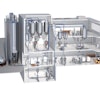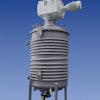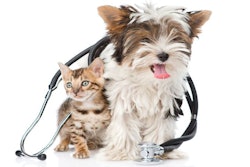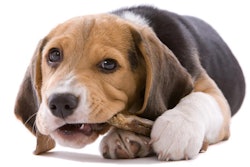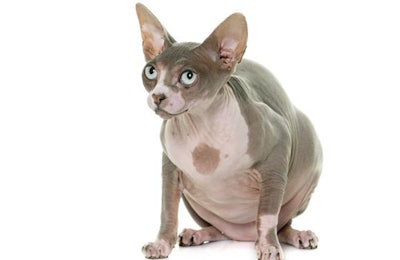
Scientists found evidence that the calories displayed on pet food labels may underestimate the true amount of energy contained in the cat and dog foods, with repercussions for pet obesity. This calorie-count problem may result from a calculation used when determining the calories displayed on pet food labels. That mathematical tool, the modified Atwater equation, may be inaccurate since many dog and cat foods now contain premium ingredients that are more highly digestible than the equation assumes.
University of Guelph animal bioscientist, A.K. Shoveller, PhD, and her team conducted an experiment to compare real cats’ digestion of commercial cat foods with the caloric contents claimed by the label, which were estimated using the modified Atwater equation. Her team published their results in Veterinary Sciences. The results may apply to the entire pet food industry, not just cat food.
“This research provides cat food formulators with insights on certain inaccuracies regarding energy density that currently span the industry,” Shoveller told Petfood Industry. “Looking at our digestibility values, we realize that the high quality of ingredients used in current formulations equates to very efficient digestion of diets.”
The modified Atwater equation doesn’t account for differences in energy lost in urine and feces, which depend on diet and the particular animals being fed, she said. Therefore, it cannot accurately determine metabolizable energy content for specific individual pets.
“For the most part, few companies conduct animal experiments to quantify the energy density of complete and balanced foods and instead calculate the energy density based on the modified Atwater equation,” she said. “Therefore, the labeling is not necessarily incorrect, but often times is inaccurate.”
Her team found that the modified Atwater equation may be underestimating the energy that cats can actually extract from the food. That may result in calorie counts that are too low. As a result, even the portion recommended based on a cats’ weight would have excess calories. However, many pet owners already overfeed their animals, Shoveller noted. The surplus calories given as a result of the inaccurate calculation exacerbate the problem, and contributes yet another cause to the pet obesity epidemic.
Cat food energy content experiment
Shovellers’ team fed three distinct cat foods to six neutered male cats and six spayed females of similar age and weight. The scientists selected cat foods based on the hypothetical energy density of their ingredients, which they called perceived glycemic response (PGR). They determined the supposed energy density by looking at the known glycemic indexes of the main carbohydrate sources included in each diet.
“The term PGR was created by our lab to describe the hypothetical glycemic response we would expect to observe after consumption of the diets,” Shoveller said. “We did not measure the glycemic responses to these diets; however, we were aware of the known glycemic indices of the specific carbohydrate ingredient sources included in the diets. The glycemic index of an ingredient is a quantitative measure of its glycemic response and compared to the glycemic response of a known control, such as white bread or 50g of glucose. Based on the known responses of ingredients used in the diets, we classified them as High, Medium and LowPGR.”
Three commercially available brands were studied:
- HighPGR: Purina ONE Chicken and Rice was chosen as the high PGR diet due to its high inclusion of brewer’s rice, a high glycemic index grain.
- MediumPGR: Iams Kitten Proactive health comprised ingredients such as corn meal and sorghum, that both elicit a lower glycemic response than brewer’s rice.
- LowPGR: Innova Dry Adult Cat Food uses barley, a low glycemic index carbohydrate, and has high protein inclusion.
After 5 days of the cats eating one of these diets, Shoveller’s team began collecting cats’ feces and urine. That continued for five days. Each cat was cycled through a 10 day period of each of the three cat foods.
Analysis of the urine and feces showed that apparent protein, fat, and organic matter digestibility differed among diets, although apparent dry matter digestibility did not.
This means that the cats could efficiently digest and absorb macronutrients, regardless of its PGR. Ultimately, the modified Atwater equation underestimated metabolizable energy by approximately 12 percent, compared to the experimental results with real cats.
Correcting pet food calorie calculations
However, all is not lost for the mathematical legacy of late-19th-century chemist and nutrition pioneer Wilbur Olin Atwater, PhD. A different version of his equation may be able to correct this underestimation of pet food calories.
“In a perfect world, diets with high digestibility would use the traditional Atwater equation to calculate energy density of their feed; however, this may result in under-prediction of feeding guidelines for diets with digestibility that is lower in contrast to the diets we examined,” said Shoveller. “The traditional Atwater equation uses higher coefficients for protein, fat and nitrogen free extract (carbohydrates) compared to the modified equation, and doesn’t underestimate analyzed ME [metabolizable energy] to such a great extent.”
Her current paper didn’t specifically examine differences in those macronutrients’ utilization, but it did conclude that ingredients with different perceived glycemic responses are actually digested similarly, when processed appropriately.
The next step in her research will be to investigate differences in glycemic responses in cats fed the three diets. She plans to observe whether glycemic response variance results in differences in macronutrient utilization.

